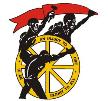The dead hand of Comrade Joseph Djugashvili (Stalin) has come alive again in Cosatu, when its executive blocked out the name of a hero of the trade union struggle from the eyes of the living last week.
Who can forget those serial photographs from the great and glamorous Soviet Union, when one by one the names and faces of the former comrades of Lenin, and the comrades of Stalin, were airbrushed out of history, as if they had never been born?
Usually, but not always, they were killed first. And the Communist Party of South Africa cheered, as one by one, or thousands by thousands, the heroes of the revolution were dispatched to their terrible fate. Then in the Soviet Union came the doctoring of history.
Towns, streets, trade union offices, party buildings, barracks, schools - all were renamed, as the comrades of the past became a nothing. No photograph could be allowed to recall them, as if the mere memory of the murdered individual might incite a tiny spark of thought among the cowed masses, in mute criticism of the regime of the Great Murderer at the head of Party and State.
Now it is the turn of Moses Mayekiso, the celebrated founder of the National Union of Metalworkers of South Africa (Numsa).
There is no need to speculate whether or not the South African Communist Party might ever wish (or not wish) to emulate its former idol, Stalin, in the manner of disposing of its political rivals. It is significant, however, that the comrades within the Numsa executive have emulated Stalin in effacing the name of Moses Mayekiso from one of the union's most celebrated buildings, the Moses Mayekiso Conference Centre in Johannesburg.
Mayekiso's "crime" was to announce his support for the Congress of People, the breakaway grouping from the African National Congress (and the SACP) formed by the former Defence Minister and ANC chairman, Mosiuoa Lekota, and the former premier of Gauteng province, Mbhazima Shilowa.
In response, Party comrades in the Numsa executive indicated their own disgrace last week, by draping a black cloth across the name of Mayekiso at the front of the buillding, sited at the corner of Gerard Sekoto and Bree Streets, about 150 metres from the Market Theatre.
As reported in Business Times (9 November), Numsa's executive voted to change the name of the Mayekiso Centre "in line with Cosatu's position that its unions should not be seen adopting the name of a 'sell-out'" - its reference both to their former leader and to the new party. According to Mziwakhe Hlangani, spokesperson for Numsa, Mayekiso, who is joining the new party, is no longer part of Numsa. "Numsa will involve its members in coming up with a new name, but in the meantime there is a black cloth around the Numsa building, also named after Mayekiso. Black symbolises that the union is mourning his departure from the ANC" (see here).
In this way the Numsa executive replicates the Stalin school of history, burying the memory of the charges of treason, subversion and sedition brought against five activists, the Alexandra Five, headed by Mayekiso, in February 1987. Mayekiso, then an official of the Metal and Allied Workers Union (Mawu), had been detained by the apartheid regime since May 1985. A major international campaign was organised in defence of the accused. (See here).
Mayekiso said last week: "When Numsa named the building after me, it was an accolade to the collective leadership of my era, and I made this clear when I received the honour. Although they can remove my name, they cannot erase the rich history of the past leadership, and this just shows the political intolerance in the Tripartite Alliance."
Click here to sign up to receive the Politicsweb daily headlines in your morning inbox

